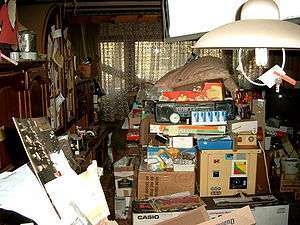Hoarding
Hoarding is a behavior where people or animals accumulate food or other items.
Animal behavior
Hoarding and caching are common behaviors in many bird species as well as in rodents. Most animal caches are of food. However, some birds will also stingily collect other items, especially if the birds are pets. Magpies are infamous for hoarding items such as money and jewelry. (Contrary to popular belief, research suggests magpies are no more attracted to shiny things than other kinds of items.) One theory suggests that human hoarding may be related to animal hoarding behavior, but substantial evidence is lacking.[1]
Human hoarding
Civil unrest or threat of natural disaster may lead people to hoard foodstuffs, water, gasoline and other essentials that they believe, rightly or wrongly, will soon be in short supply. Survivalists, also known as preppers, often stockpile large supplies of these items in anticipation of a large-scale disaster event.
Anxiety disorder and hoarding

Hoarders are people who experience feelings of anxiety or discomfort about discarding unneeded items or items of no value due to a feeling of attachment to these items. Compulsive hoarders will equate certain, usually mundane, objects to their own personal identity or even give them certain human characteristics. They may place exceptional value or importance to items that would otherwise be considered trash and feel intense distress at the thought of disposing of these items.
In severe cases, houses belonging to such people may become a fire hazard (due to blocked exits and stacked papers) or a health hazard (due to vermin infestation, excreta and detritus from excessive pets, hoarded food and garbage or the risk of stacks of items collapsing on the occupants and blocking exit routes).[2]
According to the Diagnostic and Statistical Manual of Mental Disorders, Fifth Edition,[3] the symptoms for hoarding disorder include:
- A. Persistent difficulty discarding or parting with possessions, regardless of their actual value.
- B. This difficulty is due to a perceived need to save the items and to distress associated with discarding them.
- C. The difficulty discarding possessions results in the accumulation of possessions that congest and clutter active living areas and substantially compromises their intended use. If living areas are uncluttered, it is only because of the interventions of third parties (e.g., family members, cleaners, authorities).
- D. The hoarding causes clinically significant distress or impairment in social, occupational, or other important areas of functioning (including maintaining a safe environment for self and others).
- E. The hoarding is not attributable to another medical condition (e.g., brain injury, cerebrovascular disease, Prader-Willi syndrome).
- F. The hoarding is not better explained by the symptoms of another mental disorders (e.g., obsessions in obsessive-compulsive disorder, decreased energy in major depressive disorder, delusions in schizophrenia or another psychotic disorder, cognitive deficits in major neurocognitive disorder, restricted interests in autism spectrum disorder).
Treatment
At this time there are no medications currently approved by the Food and Drug Administration for treating the symptoms of hoarding. Some medications, such as selective serotonin reuptake inhibitors (SSRIs) and serotonin/norepinephrine reuptake inhibitors (SNRIs), can be used off-label for individuals diagnosed with hoarding disorder.
The primary treatment for hoarding disorder is individual psychotherapy. In particular, cognitive behavior therapy is regarded as the gold standard for treating the disorder.
See also
- Hoard (archaeological)
- Hoarding (economics)
- Collyer brothers, rich eccentrics who were noted for compulsive hoarding
- Plyushkin, fictional Russian hoarder
- Digital hoarding
References
- ↑ Andrews-McClymont, Jennifer G.; Lilienfeld, Scott O.; Duke, Marshall P. (Dec 2013). "Evaluating an animal model of compulsive hoarding in humans". Review of General Psychology. 17 (4): 399–419. doi:10.1037/a0032261. Retrieved 16 April 2014.
- ↑ "Hoarding", Mayo Clinic, 2012. Retrieved 2013-05-19.
- ↑ Diagnostic and Statistical Manual of Mental Disorders (5th ed.). Washington, DC: American Psychiatric Association. October 3, 2013.
Further reading
- Tolin, David; Frost, Randy; Steketee, Gail (2007). Buried in Treasures: Help for Acquiring, Saving, and Hoarding. Oxford: Oxford University Press. ISBN 978-0-19-530058-1.
- Neziroglu, Fugen; Bubrick, Jerome; Yaryura-Tobias, Jose (2004). Overcoming Compulsive Hoarding: Why You Save & How You Can Stop. California: New Harbinger. ISBN 978-1-57224-349-1.
- Steketee, Gail; Frost, Randy (2006). Compulsive Hoarding and Acquiring: Workbook. Oxford: Oxford University Press. ISBN 978-0-19-531055-9.
- Steketee, Gail; Frost, Randy (2006). Compulsive Hoarding and Acquiring: Therapist Guide. Oxford: Oxford University Press. ISBN 978-0-19-530025-3.
- Steketee, Gail; Frost, Randy (2011). Stuff: Compulsive Hoarding and the Meaning of Things. Oxford: Oxford University Press. ISBN 978-0547422558.
- Nolen-Hoeksema, Susan (2014). (ab)normal Psychology. Penn Plaza, New York: McGraw Hill Education. ISBN 978-0-07-803538-8.